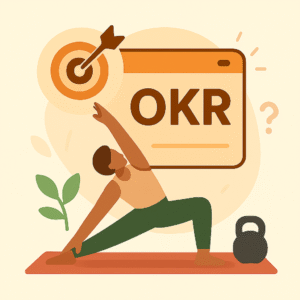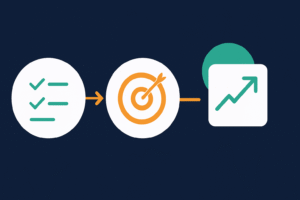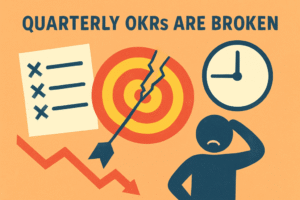Why OKR vs KPI Confuses Teams
In conversations with teams across industries, one recurring confusion keeps surfacing: “Aren’t OKRs just KPIs with goals?” It’s a fair question – and one I’ve heard countless times when working with organizations on their transformation journeys.
Here’s what usually happens: someone attends a conference, gets excited about OKRs, and suddenly every metric becomes an objective. Meanwhile, the operations team keeps asking for their KPIs. The result? Nobody knows what they’re actually measuring or why.
Let me clear up this confusion and show you what makes Objectives and Key Results fundamentally different from Key Performance Indicators – and more importantly, how they work together.
What’s the Real Difference? Progress vs Performance
Think of KPIs as your organizational vital signs: your daily pulse, temperature, and blood pressure. They tell you how well your business is functioning right now.
OKRs are more like your fitness goals: designed to push you beyond your comfort zone toward something better.
Here’s something I’ve learned after years of helping organizations implement both: when companies force metrics on people, they stop caring about doing good work. I’ve seen development teams proudly hit “42 story points in a Sprint” while actual customer value got worse.
KPIs track performance – “How are we doing right now?” OKRs set ambitious goals – “Where do we want to go next?”
As I discussed with Dave Sharrock on our podcast: “OKRs measure progress. They don’t measure performance… They’re there to create alignment so that you can see progress and that progress is aligned to what your overarching goals are.” (How OKRs Drive Strategic Alignment and Team Autonomy)
The biggest trap? Assuming these are interchangeable.
To echo John Doerr, author of Measure What Matters,
“We must realize that OKRs are not a checklist of tasks—they are about outcomes. KPIs may tell you if you’re on track, but OKRs help you change the track itself if needed.”
(Measure What Matters, 2018)
For more examples of how organizations separate OKRs from KPIs, see Atlassian’s OKR vs KPI guide.
Can You Use OKRs and KPIs Together?
Absolutely. In fact, the most effective teams do.
From my work with organizations: “You still need KPIs because your OKRs are not going to give you the performance of the organization. The performance of the organization is going to be measured by your KPIs.” (Revolutionizing Business Goals with OKRs)
Imagine you’re on a road trip. Your OKR is your destination: “Drive to the Rocky Mountains in 2 days.” Your KPIs are your dashboard: speed, fuel, tire pressure, engine temp. Both matter. One tells you where you’re heading; the other keeps you on track.
When to Use Each: A Practical Guide
Note: Some initiatives may require both frameworks – think of this table as a guide to primary intent, not strict categories.
| Use Case | Use OKRs | Use KPIs |
| Launching a new product | Yes | Sometimes |
| Monitoring customer satisfaction | No | Yes |
| Driving culture change | Yes | Rarely |
| Ensuring SLA compliance | No | Yes |
For a detailed breakdown of how OKRs are applied in practice, explore Google’s OKR Playbook.
You can include customer metrics in an OKR when focusing on improvement goals (e.g., “Increase NPS from 40 to 60”), but use KPIs for ongoing monitoring of satisfaction levels.
Use OKRs when:
- You’re driving change or launching new initiatives
- You need alignment across teams: “they enable autonomy for teams aligned to that larger piece” (Revolutionizing Business Goals with OKRs)
- You want stretch goals that push boundaries while remaining measurable and realistic within your timeframe
Use KPIs when:
- You’re tracking regular operations
- You need ongoing monitoring
- You want historical trends
As Andy Grove emphasized in High Output Management,
“OKRs should be few in number and focused, serving as the critical drivers for growth, while KPIs maintain the health of the business.”
(High Output Management, 1983)
Common Pitfalls and How to Avoid Them
Mistake #1: Using KPIs as OKRs “Reduce support tickets to under 20” is a KPI target, not a stretch goal. I recently heard Gino and Wayne on their Good Intentions, Bad Outcomes podcast share a perfect example: managers setting key results as rigid performance targets. As Wayne explained: “a leader sets a key result and hands that to the team as though that’s what they have to work for, which takes their autonomy away. They feel less motivated, less bought in when somebody’s giving them something that they have to reach.”
Mistake #2: Tracking too many OKRs Focus is key. Three to five per team is more than enough. As I tell teams: “if you keep hitting your OKRs every single time and achieving them, then you’re not stretching yourself enough.” (Revolutionizing Business Goals with OKRs)
Mistake #3: Setting OKRs without knowing your baseline KPIs You can’t know where you’re going unless you know where you are.
Mistake #4: Treating OKRs as performance targets While some organizations attempt to tie OKRs to performance reviews, particularly at senior levels, in our experience this undermines psychological safety and motivation. OKRs work best when they’re used to drive alignment and learning, not judgment.
As Gino noted on their podcast, when teams are given unrealistic targets, “their actions actually get disconnected from the outcome that they want to achieve… they might miss out on opportunities to meet those outcomes in a cheaper way, in a more effective way.”
Christina Wodtke, in Radical Focus, reinforces this point:
“OKRs work best as a learning and alignment tool, not a weapon for performance reviews. When misused, they do more harm than good.”
(Radical Focus, 2016)
Best Practices for Combining OKRs and KPIs
- Define your KPIs before drafting OKRs – Know your baseline
- Use KPIs to inform progress on key results – Let data guide decisions
- Focus on trends, not snapshots – As Dave and I discussed: “There’s a big difference between a snapshot in time in a dynamic world versus a snapshot in time of something which is a lot less dynamic.” (Dashboards)
- Expect iteration – “OKRs are surprisingly tricky… you won’t get them right the first time” (How OKRs Drive Strategic Alignment and Team Autonomy)
- Make transparency critical – “OKRs are intended to be transparent. Anybody should be able to see what anybody else in the organization’s OKRs are.” (Revolutionizing Business Goals with OKRs)
You can also review OKR Institute’s case studies to see how different companies align OKRs and KPIs in real scenarios.
Make the Tools Serve the Strategy
Don’t fall into the trap of debating whether OKRs or KPIs are “better.” They serve different, complementary purposes.
The real magic happens when you use both frameworks thoughtfully. You’ll have teams that know where they’re going (OKRs) and can monitor their progress along the way (KPIs).
For a deeper dive into OKR implementation, check out my colleague Alexander’s comprehensive FACTS Framework guide.
Ready to Master OKRs vs KPIs?
Want a clear, side-by-side breakdown of when to use each framework? Download our free OKR vs KPI Comparison Guide – a practical PDF perfect for leaders, product owners, and team coaches navigating goal-setting confusion. It shows you exactly which framework fits your specific situation.
Download Your Free OKR vs KPI Guide → Resource – Xodiac | Business Transformation Consultancy
FAQ
What is the difference between OKRs and KPIs? OKRs are goal-setting tools designed to align teams around ambitious outcomes. KPIs are performance indicators that track how well you’re doing against operational benchmarks.
Can OKRs and KPIs work together? Yes. They work best when OKRs define the goal and KPIs show the impact.
Should I replace my KPIs with OKRs? No. Keep your KPIs to measure performance, and add OKRs to drive strategic alignment and improvement.




